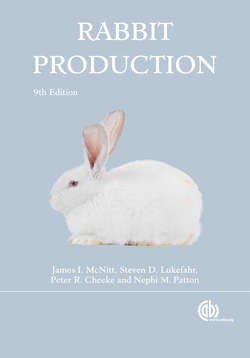Читать книгу Rabbit Production - James I McNitt - Страница 35
На сайте Литреса книга снята с продажи.
Feeding Equipment Feeders
ОглавлениеVarious types of feed hoppers are commercially available. The most popular is the J feeder (Fig. 4.11). Hoppers should have sufficient capacity to hold at least a one-day feed supply and should be designed so feed is not scratched out (scrabbled) and wasted. If scrabbling is a problem, a scrabble guard can be made by inserting a piece of 2.5 × 5.0 cm cage wire into the feeder above the feed. Wires placed 5.0 to 7.5 cm apart over the opening may be needed to prevent young rabbits from getting into the hopper. Some feeders have mesh or slotted bottoms that allow fines to fall through. This assures the rabbits of good quality pellets. The presence of fines may reduce feed intake and growth performance. Crocks may be used in small rabbitries, but they require a lot of labor for cleaning, because they are often soiled with feces and urine. Wastage is often a problem.
Fig. 4.11. An example of a J feeder, with a mesh bottom to allow fines to sift out of the feed (right) and a feeder with a solid bottom (left). (Courtesy of D.J. Harris)
Feeders should be regularly checked for problems. Rough edges can cause hair loss on the faces of rabbits or cuts that become infected and develop into abscesses. Rabbits may chew small holes in the mesh bottoms of feeders. These holes generally occur where the mesh screen joins the metal and are difficult to see. Feed is observed under the cage, and it is assumed that the rabbits are scratching it out, but the real problem may be a hole in the feeder. As a result, slotted hoppers may be preferred in large rabbitries. Stainless steel feeders should be considered, as they look better and last considerably longer than galvanized feeders. Feeders should also be checked for wetness (the rabbits may soil the feed, water may drip into the feeders, or the pellets may absorb moisture from the air) and for stale, moldy, or caked feed. Feeders should be cleaned and sanitized on a regular basis. Feed crocks on the inside of the cage should be sanitized more frequently than feed hoppers on the outside of the cage.
